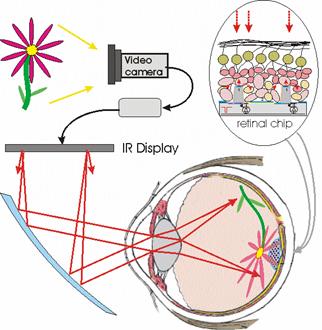A “bionic eye”, engineered at Stanford University, California, may one day help blind people see again. The eye implant could be a dramatic step above currently available implants which have very low resolution.
A visual acuity of 20/20 is considered normal, while 20/400 is considered blind. The device could provide acuity of 20/80. “With 20/80 vision you can certainly read large forms and live independently,” says physicist Daniel Palanker.

The 3-millimetre-wide chip would have to be implanted behind the retina of the blind person. The patient would wear goggles mounted with a small video camera. Light enters the camera, which then sends the image to a wireless wallet-sized computer for processing. The computer transmits this data to an infrared LED screen on the goggles.
The goggles reflect an IR image into the eye and on to the retinal chip, stimulating photodiodes on the chip. The photodiodes mimic the retinal cells by converting light into electrical signals, which are then transmitted by cells in the inner retina via nerve pulses to the brain.
When the implants were used in blind rats, the rodents appeared to have some restored vision.
Before the device can be stepped up to humans, Palanker says the team will have to trial larger implants in bigger animals and conduct more tests.
Via New Scientist.
See also Slashdot story about Artificial Silicon Retina microchips implanted in the eyes to treat vision loss. The implant is a 2mm chip containing about 5,000 microscopic solar cells that convert light into electrical impulses.
